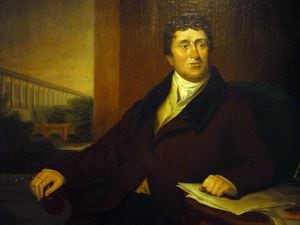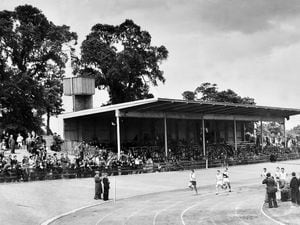The life and times of Thomas Telford, celebrated civil engineer who helped shape modern Britain
What did Thomas Telford ever do for us?

Well, if you're reading this while driving along the A5 you can mention to the police when they stop you that we have him to thank for the quality of the road and its gentle gradients.
Then there's Pontcysyllte Aqueduct, soaring and majestic, a bit of a white elephant as originally conceived but now a leisure, recreational and heritage jewel which not all that long ago was designated a World Heritage Site to rank it alongside the Pyramids in global importance – one of the wonders of the world.
Without Thomas Telford, residents in a certain Shropshire town would now be living in a different place, with a name perhaps like Wrekin City, which was among the suggestions, although there was a body of opinion that it should be named Dawley to reflect the Dawley New Town origins.
Roads, bridges, canals, churches... and that's only some of the work that Thomas Telford crammed in to his workaholic lifestyle.
In a punning description which would not be out of place in a modern tabloid, the contemporary poet Robert Southey described him as “the Colossus of Roads”.

With his fingerprints over a large and wide range of projects, there are functional monuments to his greatness all over Britain, part of the nation's infrastructure to this day, although it has to be said that he wasn't really one for railways, which came along too late in his life for him to make his mark with them.
His prowess and reputation helped to forge a profession, that of civil engineer – he was appointed the first president of the Institution of Civil Engineers in 1820, a masterstroke which greatly increased the clout and prestige of the fledgling institution.
On a personal level, Telford did not marry, and the superficial impression might be of a rather dour Scot who lived for his work. However the evidence from his contemporaries points to him being a sociable man of good humour and with a ready laugh, who made for good company, and who had a large circle of acquaintances, although few if any really close friends.
Isambard Kingdom Brunel is a household name on the back of a small number of high profile projects. Abraham Darby III is in the history books for just one bridge-building feat, the world's first iron bridge. Yet despite being behind literally hundreds of projects, including 40 bridges in Shropshire alone, for a long time Telford was something of a forgotten giant.
When the town of Telford was named after him in 1968 there were locals who had not heard of him or who were fuzzy on what he had actually contributed, which, funnily enough, in the area actually encompassed by Telford New Town wasn't all that much – mainly a church in Madeley.

The second part of the 20th century was to see his work newly appreciated and for him to take a proud place on the podium of engineering geniuses who have shaped our world.
Downsides to Telford? He was the star of his own autobiography. Nothing unusual in that, but there is a feeling that he gave himself credit for some things, or was given the credit for them, when others perhaps should have received a greater share.
Partly that will be because of the way he worked. He trained, mentored and developed young engineers and cascaded work down and stretched them.
The level of his direct involvement in projects varied.
An example of Telford blowing his own trumpet and putting somebody else in the shadow, to mix metaphors, was with the Pontcysyllte Aqueduct.
In his autobiography he didn't even mention the contribution of William Jessop, the overseeing engineer, who was the one who had his head on the block.
The structure carries the Llangollen Canal over the River Dee valley near Chirk. And by the way, the meaning of Pontcysyllte (pronounced “Pont-kus-ull-te”) is simply “connecting bridge”.

But let's go to his humble beginnings in Scotland. Thomas Telford was born on August 9, 1757, in a cottage in Eskdale, in a place so small that it only features on the most detailed Ordnance Survey maps – and then in the smallest print.
To find it, you need to look to the north west of Langholm, and then branch off up lonely Meggat Water and to the tiny settlement of Glendinning. The actual cottage no longer exists.
His father was a shepherd whose name was John Telfer, who died when Thomas was only a few months old. Mother and baby had to move into another shared cottage, with just one room to themselves.
At some point Tam or Tammy, as he was known in his childhood, became Telford rather than Telfer, perhaps not a significant change in times of poor literacy, although he was certainly not illiterate himself and sought to learn and improve himself from a young age.
The only child of a single parent in an era typically of large families, it seems on the face of it an impoverished and lonely upbringing, but he looked back on those times in later life with nostalgic fondness, and he had a capacity for making friends and a talent for what we would today call networking.

After learning his trade as a mason, he headed south to England in 1782, where he saw there were greater opportunities.
It was his good connections which brought him to Shropshire in 1786, when the wealthy William Pulteney, who was both Shrewsbury’s new MP and an old Scottish associate whom Telford knew, liked, and had worked for previously, sought him out when he was looking for someone to turn Shrewsbury Castle into his home.
According to the ICE, after his restoration Telford lived in the castle and practised from there as an architect.
One recurring theme of Telford's life was his good fortune, time and again being in the right place at the right time. Shropshire was looking for a county surveyor, and that role fell to Telford. As Shropshire’s first surveyor of public works – a post he held until his death – a whole new world of roads, bridges, and public buildings opened up.
Then there were those little incidents which cemented his growing reputation.
One often repeated anecdote is that the churchwardens of (old) St Chad's Church in Shrewsbury sought his help with the renovation of the dilapidated church.
He told them it was in danger of collapse, which is not what they wanted to hear, so they appointed a local stonemason to do some patching up.
Not long afterwards, the church collapsed, just as Telford had warned.

A lesser-known aspect of his life is that he was a Freemason – a member of a fraternal organisation of shared ideals and morality and a commitment to helping each other.
According to research by Alan Thomas Howls, Telford attended, together with 23 other members of Salopian Lodge, one of the first Provincial meetings ever held in Shropshire, at Whitchurch, on June 24, 1789, to celebrate the Festival of St John the Baptist.
And on July 17, 1789, Telford was present when William Hazeldine, the renowned ironmaster, was initiated into Salopian Lodge. The pair were to work closely together over the next 20 years.
His time in Shropshire made him a rising star, and a go-to man for major projects of national significance.
The Government turned to Telford to improve the road from Shrewsbury to Holyhead and, separately, that from Shrewsbury to London.
His improvements to Holyhead Road took place in stages between 1815 and 1829. Through North Wales it still follows the original line surveyed and chosen by Telford, and the road is considered a historic route.
Particularly in the difficult and mountainous terrain of North Wales, modern motorists still benefit from his far-sighted approach, as he would not tolerate steep slopes, and flattened the whole route through grading, levelling, and rerouting.

In the Highlands of Scotland, Telford was responsible for about 1,200 miles of new or improved roads.
The Caledonian Canal is a great monument to his genius.
It was conceived as a great inland waterway across Scotland, removing the need for ships to negotiate the hazardous sea route through the Pentland Firth.
Again, Telford had to contend with difficult and mountainous terrain.
There were immense engineering challenges, with work starting on the 60-mile canal in 1804. It includes 37 miles routed through natural lochs.
When it was finished in 1822 the scheme was 12 years behind schedule and massively over budget.

Like Pontcysyllte, it was not a commercial success. And like Pontcysyllte, the dramatic scenery saw it become a tourist attraction, and it is today one of Scotland's tourism and heritage gems.
In the view of many, his finest work of all is the Menai Suspension Bridge, which turned Telford into a civil engineering superhero – and saved an untold number of lives.
Built between 1819 and 1826, it is more than 1,000ft long and 100ft above sea level, with a deck suspended by wrought iron cables.
Getting from the mainland to Anglesey had been a hazardous business by ferry, amid the tricky currents of the Menai Straits. Boats foundered or capsized, and lives were lost.
And with Ireland joining the UK through the Act of Union in 1800, the route to Holyhead became an important roadway as it was a journey politicians commuting to and from Ireland to parliament had to make.
Telford's iconic structure was the world's longest suspension bridge of its day.


Not everything he touched turned to gold. He was consultant on rebuilding London Bridge in 1800 and came up with an elegant and bold single span design of iron, which was not accepted.
His work meant he was a bit of a nomad. His base was in London, where he found rooms in a coffee house called, perhaps coincidentally, perhaps not, The Salopian, near Charing Cross. He was to remain there for 21 years and became a fixture, and it was not until he was 64 that he had a home of his own, at 24 Abingdon Street, Westminster.
He amassed considerable wealth, but was clearly not money-motivated, and was generous to friends, colleagues, and even strangers.
He died without any surviving blood relatives on September 2, 1834 at the age of 77. He had wanted to be buried in the parish church at Westminster, but such was the esteem in which he was held that he was buried in Westminster Abbey.






